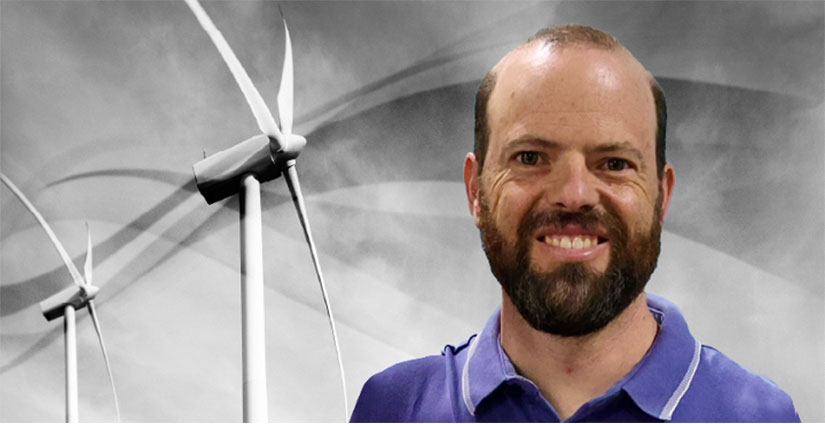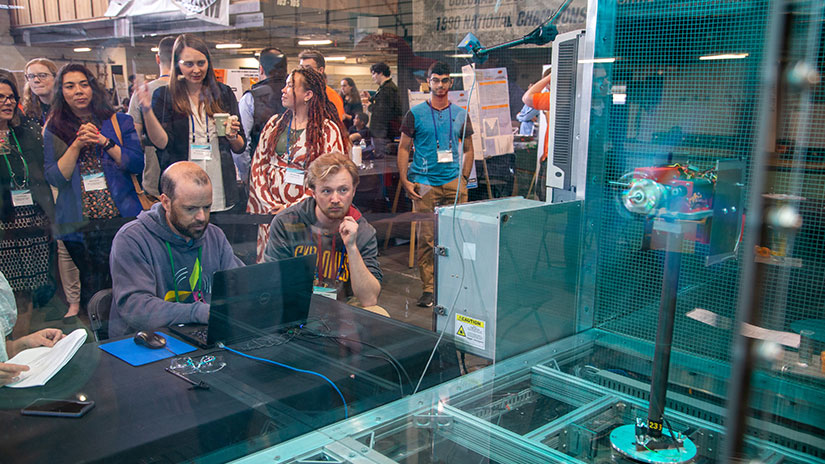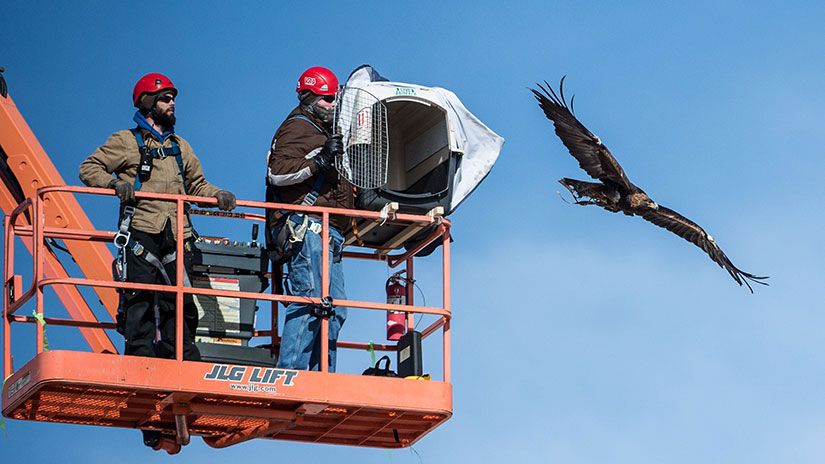Behind the Blades: How Jason Roadman's Daily Commute Inspired a New Career Path
A Wind Energy Field Engineer Reflects on Equipping Eagles With Flight Trackers, Preparing College Students for Careers in Clean Energy, and Using His Knowledge To Make a Positive Impact

Wind turbines loomed large in Jason Roadman’s consciousness before he ever carried a National Renewable Energy Laboratory (NREL) employee badge.
In the late 2000s, Roadman lived in Golden, Colorado, and was working on a master of science degree in aerospace engineering at the University of Colorado Boulder. His daily commute took him along Colorado State Highway 93, a windblown road that traverses the eastern base of the Rocky Mountains and passes by NREL’s Flatirons Campus—home to the National Wind Technology Center.
“I saw the campus’s first utility-scale wind turbines go up, and I thought, ‘Those look really cool,’” Roadman recalled.
But it was not just the novelty of the wind turbines that interested Roadman. It was the idea of using his aerospace training to make a positive impact.
“One career path available to me with my aerospace degree was weapons design and manufacturing,” Roadman explained. “But I wanted to use my knowledge to help rather than hurt. I knew wind turbines create electricity without polluting the air, which helps the environment. And I figured there was some aerospace engineering involved in wind turbines.”
Inspired by this alternative path, Roadman started exploring his networks. Pat Moriarty, an NREL engineer who Roadman knew through his master’s degree committee, encouraged Roadman to apply for an engineering contractor position at NREL. Roadman got the contractor job in 2011 and became a full-time NREL researcher in 2014.
Today, Roadman is an applied research engineer at the National Wind Technology Center, where he coordinates and conducts field experiments on the campus’s research wind turbines and is the designated area representative for the U.S. Department of Energy’s (DOE’s) 1.5-megawatt (MW) turbine. Roadman also serves on the team that organizes the DOE Collegiate Wind Competition (CWC), an annual competition that helps college students prepare for jobs in wind and renewable energy.
For the following conversation, we caught up with Roadman as he was setting up an experiment on the DOE 1.5-MW turbine to measure acoustic emissions.
To get started, in layman’s terms, what do you do at the National Wind Technology Center?
As an applied research engineer, I take a variety of sensors and put them on wind turbines to measure how the turbines do different things. For example, today, I’m measuring the level of noise the DOE 1.5-MW turbine produces while its blades are spinning. For other experiments, I might measure how much power turbines generate given the environmental conditions. How do the turbines respond to temperature, air pressure, humidity, or other environmental changes? How much load, or stress, are the turbine’s blades and the rest of the turbine structure experiencing? I provide these data to other researchers or industry partners for analysis.
Then, as an organizer for the CWC, I lead the development of our annual rules document and maintain and upgrade our wind tunnels, which teams use to test their model wind turbines at our final event. During the competition’s final event each spring, I act as head rules judge, meaning I ensure all student teams comply with the rules, and I work with the CWC organizers to address questions about the rules. I also act as the turbine testing judge, meaning I inspect the turbines for compliance and run the wind tunnel when the students are testing.

What problems do you solve, or what needs do you meet, by running field tests on wind turbines and helping organize the CWC?
Regarding my field experiment work, I help drive the research that prepares wind turbines for the commercial market. The Flatirons Campus was built in a unique wind environment. Because of our location on the eastern base of the Rocky Mountains and at the mouth of Eldorado Canyon, we get extremely variable wind conditions and wind speeds higher than what most wind farms see annually. That means we’re able to characterize, or report, the types of intense conditions that a wind turbine may experience. A lot of our work involves using the various research turbines on campus to predict how well newer turbines can stand up to intense wind conditions. Also, because the wind conditions at our location change so frequently, we can test new technologies more quickly than we could at a location with less variable conditions.
When it comes to my work on the Collegiate Wind Competition, both land-based and offshore wind energy are poised for significant growth over the next few decades, which means those industries are going to need a huge influx of workers to fill all kinds of roles—not just engineers, but finance folks, environmental analysts, and public relations specialists. The CWC helps educate that next generation of workers, equipping them with the skills, knowledge, and professional connections that will help them break into the industry.
What are you working on right now that you’re especially excited about?
We just wrapped up the 2024 Collegiate Wind Competition, and we’re still accepting applications for CWC 2025! We held CWC 2024 May 6–9 at the American Clean Power Association’s CLEANPOWER conference in Minneapolis. The competition is always a great culmination of the work the students have done over the past school year, and it’s a great networking opportunity. Students get to meet each other and share ideas, and, because the final event takes place at a conference for members of the renewable energy industry, they sometimes even meet their future employers. It’s very rewarding to know that the CWC is helping college graduates find jobs and helping the wind and renewable energy industries find workers.
I can tell the CWC really fills your sails, so to speak! What other projects have you been equally jazzed about?
Back in 2016, we did an experiment gathering bird flight data to help companies that were developing technologies reduce bird collisions with wind turbines. We had a group of researchers who were designing systems that would detect birds and bats around wind turbines, with the idea that the turbines would stop spinning before the animals got close. The researchers wanted to test how well the technology could detect real flying objects, but at the time, Federal Aviation Administration regulations made it difficult to fly unmanned aircraft.
I got the idea to put a GPS tracker on an actual bird and fly it around the turbines at the Flatirons Campus. My sister, a wildlife biologist, encouraged the idea. I went down to the local hawking club and, surprisingly, several members were very interested in the research. Through those folks, I connected with Auburn University, who agreed to bring their trained eagles, Spirit and Nova, out to the Flatirons Campus for the field test. We tested two different technologies—one radar-based and one camera-based. Some wind farms now use the camera-based technology to detect golden eagles and shut the turbines down if the eagles are present. Leading that experiment, seeing these eagles fly around the campus, and knowing we were collecting data that would help keep other eagles safe around wind turbines was one of the coolest things I’ve ever done in my career.

In an NREL career highlight, Roadman worked with trained eagles to gather data on bird flight patterns. The data supported technology development to reduce bird collisions with wind turbines. Photo by Dennis Schroeder, NREL
That sounds like an amazing experience! What advice do you have for people who’d like to do what you do?
I have several pieces of advice. First, participate in an engineering and design competition, whether that’s CWC or something else. I’ve participated in engineering and design competitions in various capacities for 28 years now—first as a student competitor in junior high, high school, and college, and later as an advisor, a judge, and an organizer. The reason I’ve stayed involved with these types of competitions is they give you the chance to apply everything you learn in your engineering classes to real-world problems.
Second, don’t just network. Spend time shadowing people who are doing work that interests you. That’s why the CWC and similar programs are so beneficial: They connect students with folks in wind and renewable energy, which gives students a chance to learn firsthand about the jobs they’re studying to do. When I was in graduate school and exploring career paths, I would go to work with friends who worked at organizations I was interested in. I’d meet their colleagues and bosses, ask questions about their jobs, learn what was going on at their companies. That strategy gave me the confidence to know NREL was the right fit when the opportunity came up. When I started working at NREL, because I’d already done a lot of hands-on career exploration, I knew I’d landed in the right place. Thirteen years later, I’m still where I want to be.
Finally, if you’re a college student or professor reading this, apply for CWC 2025! We’re accepting applications until 4:59 p.m. MT on June 13, 2024.
Learn more about NREL’s wind energy research, offshore wind energy in particular, and the amazing people behind the blades by subscribing to the Leading Edge newsletter.
Last Updated May 28, 2025
